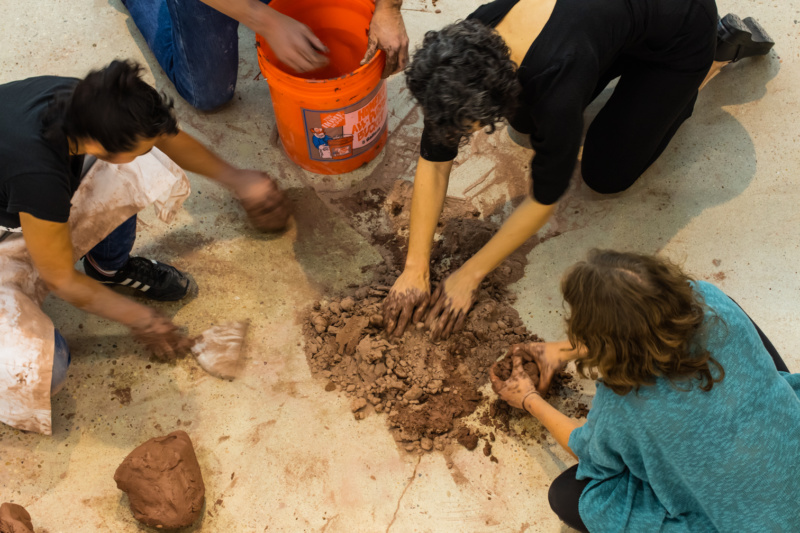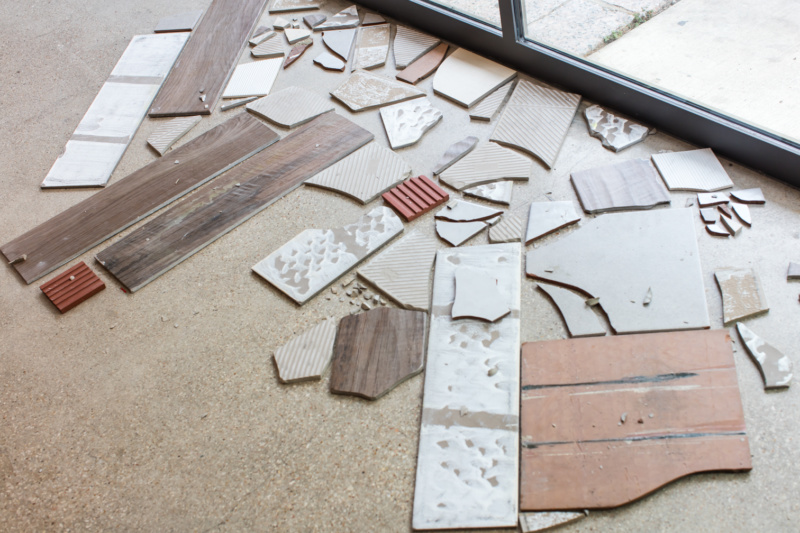
“I think it was here,” said the woman, laying a burlap sack on the floor at the Contemporary Austin on a recent afternoon. “I especially remember there was rice everywhere. There was rice until here,” she said, gesturing to a point at the middle of her calf. She recalled that there was a mother and her son, and that the child was nervous. Someone extended a piece of gaffer’s tape and had a few people hold it in place “for five minutes … half an hour … three days,” she said, pointing out where the boy was. “Actually, the kid was sitting here,” she clarified. “I was lying.”
A small group of visitors was following a duo of unreliable narrators–percussionist and sound artist Diego Espinosa Cruz González and choreographer Nadia Lartigue, both from Mexico City–around the Contemporary’s current exhibition, Abraham Cruzvillegas’s “Hi, how are you, Gonzo?”
The galleries are host to a motley and yet harmonious group of sculptures, all made by museum fabricators from found and recycled materials according to drawings made by the artist; red and black is the color scheme. Though they didn’t spell it out, the duo’s narration had to do with what had happened at the exhibition’s opening a few nights previously, when, by all accounts, things got a little loud after people learned they could touch the sculptures (which include a drum set), climb on them, pour out the rice or the seeds in some glass jars—basically do whatever they wanted.
“We had a legitimate Happening,” the Contemporary’s chief curator and director of curatorial affairs, Heather Pesanti, said during a conversation in the gallery. Pesanti organized the show along with Heidi Zuckerman, director of the Aspen Art Museum, where the show will appear in the fall.

Much of the work in the show, and much of the artist’s output overall, is based in the concept of autoconstrucción, loosely defined as self-construction, a practice common in the Mexico City slum where the artist grew up as well as other exurban areas. Squatters often build their own homes from scavenged materials, expanding and altering them as necessity dictates; neighbors often pitch in with labor and money. So it’s maybe no surprise that his sculptural installations, some of them augmented here with books and potted plants, suggest domestic environments, furnished by a highly unorthodox interior designer.
But the artist views the practice of autoconstrucción within a context of political and labor struggle by the poor and indigenous in those Mexico slums, as he outlines in “Self-Construction,” the first essay in his 2015 book The Logic of Disorder: The Art and Writing of Abraham Cruzvillegas. His work for Austin and Aspen arrives in this deeply political spirit stamped by the artist’s upbringing in Mexico City’s exurban improvised communities.
The show’s title, “Hi, how are you, Gonzo?” combines references to cult figures with links to the two cities where the show will appear. Musician and artist Daniel Johnston, whose 1983 cassette-record “Hi, How Are You” includes favorites like “Walking the Cow,” is an Austin legend. (If you haven’t seen the documentary The Devil and Daniel Johnston, you have a treat in store.) As for Colorado, “gonzo” journalist Hunter S. Thompson penned a 1970 Rolling Stone article, “The Battle of Aspen,” about the “Freak Power” mayoral campaign of lawyer-biker Joe Edwards. (Inspired by Edwards’ almost-win, Thompson would run for sheriff the next year.)
The permissive and open spirit of the exhibition’s opening night is continuing throughout the show’s run; in an uncommonly busy schedule of public programs, the exhibition will be “activated” by invited guests twice a week. The calendar of events resulted from an uncommonly democratic process in which all museum staffers, from accounting to the front desk, were solicited for suggestions about what they would like to learn—or what they would like to teach.

On the roster are people like Mexico City-based ceramicist Marcela Calderón Bony, the Bowie High School Percussion Ensemble, and herbalist Caroline Caswell, as well as cooks, distillers, skaters, and musicians. Museum staff is included too; educator Mariel Robles and her mother will host a mole-cooking workshop based on a family recipe. Some of the programs are oriented toward social justice, like a book swap that will benefit the Inside Books Project, which benefits incarcerated readers.
While the programs are diverse, they aren’t entirely a free-for-all; Cruzvillegas dictated three criteria all the public programs had to embody: warmth, ease, and necessity. Each program had to fit all three, by Pesanti and Director of Public programs and Community Engagement Andrea Mellard’s lights, but that left a lot of latitude—and quite a bit of unpredictability. “We’re waiting to see what happens just like everyone else,” Pesanti said.
Magic can happen. After nearly an hour’s performance, after González played a drum solo on the spines of a cactus, after Lartigue pointed out where there was still clay on the floor from a ceramics-making workshop on opening night, after she lay down on her back on one of the sculptures and slid to the floor, the two welcomed an unexpected collaborator. A tiny toddler in flip-flops became curious when González and Lartigue took a pile of ceramic tiles to a spot on the museum’s first floor, where glass walls face out onto the sidewalk. The artists invited her in, silently encouraging her to arrange the tiles just as she liked. The crowd was rapt as the kid sang and babbled and played with the pieces.










 in your life?
in your life?

